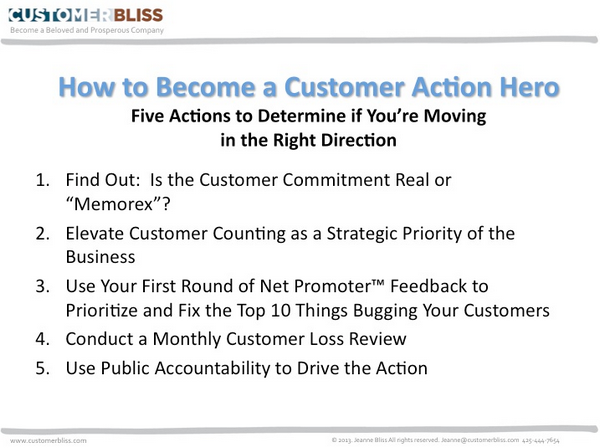This is a guest post from Jeanne Bliss — customer experience expert and author of “I Love You More Than My Dog.” See the original post this is adapted from and more like it on her blog.
All the money in the world that you throw at that Net Promoter survey won’t do any good if there’s not a commitment to do something about what you hear. Yes, customer listening is as old as the hills. Unfortunately most corporations’ ears are full of wax. If you’re really serious about becoming a Customer Action Hero, then start doing these things:

1. Find Out: Is the customer commitment real or “Memorex”?
Is your commitment to customers real or a jockeying for position on the latest customer score board?
Remember that brilliant ad campaign from the Memorex audiotape people who challenged viewers to discern if the voice singing was real or a recording? Well, you’ve got to know if the commitment is there inside your organization. Determine if the appetite exists for digging into the operations of the business to make changes based on what you hear from customers. Are leaders ready to drive accountability, provide political air cover, and insist on the corporate patience to do the work?
2. Elevate customer counting as a strategic priority of the business
Right now, you can probably recite where you are in meeting your sales goals. Do you know as much about your customer goals? These are the counts of customers in and customers out, a clear accounting for customers by revenue group, customers who renewed with you and why, and an active accounting of “promoters” and “detractors” by customer segment.
You need to recast the language of your business to be about defining your customers as the asset of your business In my book, Chief Customer Officer, I call these the ‘Guerrilla Metrics‘ because you sometimes need to wage a campaign to power the customer into the strategic conversations about how business success is defined.
3. Use your first round of Net Promoter feedback to prioritize and fix the top 10 things bugging your customers
To a large degree, sometimes inactivity from the survey data exists because people don’t know what to work on. Certainly in reviewing the data, everything seems broken. Whenever I ask customers questions, I always want to ask them how we are performing, but also how important the area is to them. That way, you can assemble a triaging system for the issues you’ve heard from customers And by knowing the issues most prevalent to “promoters” and “detractors,” you can prioritize and focus the issues.
4. Conduct a monthly customer loss review
On a monthly basis, gather a list of detractors and customers who have left. Then engage company-wide leaders to call 5-10 of these customers. This gets the voice of the customer in the ear of leaders who need to understand the nuances of your operation that are driving the wedge that either makes them “detractors” or drives them away. Compile the customer profitability information relative to these customers so there is a clear understanding of their impact to the business.
Then, monthly or quarterly run a meeting to discuss, diagnose, and attach accountability for resolving the issues. I can guarantee you; the memory of hearing customers expressing their pain from the treatment, combined with knowing the ROI impact, will inspire action.
5. Use public accountability to drive the action
Public accountability can be a powerful approach for getting action on what you hear from customer surveys, customer complaints, and feedback from the web. Simply designate a room to be “The Customer Room.” On the walls of the room, map the customer experience, corresponding metrics, the trending of your customer issues, what you are hearing from customers on the web, and the top ten operational metrics related to the biggest issues your customers want fixed.
On a quarterly or monthly basis, the CEO and leaders should walk around the room, stand before each category of information, and ask, “Why is this happening, who will fix it, and when?” When the data is organized by region and/or operational area, the friendly horse race motivates people to move up on the stack rank of performance.
Most importantly, this monthly or quarterly action moves the customer conversation into the everyday operational language of the business. This is when you get traction.
About Jeanne Bliss
As “Chief Customer Officer” for Lands’ End, Mazda, Coldwell Banker, Allstate, and Microsoft, Jeanne got “customer” on the strategic agenda, earned 98% loyalty rates, and changed experiences across 50,000-person operations. Jeanne now runs CustomerBliss to create an actionable path for profitability and business growth -- through earning customer and employee raves. Her best-selling books are Chief Customer Officer and I Love You More than My Dog: Five Decisions that Drive
- Web |
- More Posts(64)


